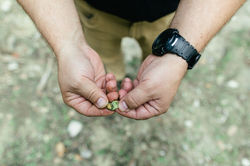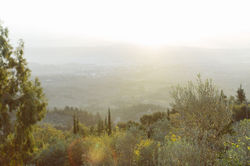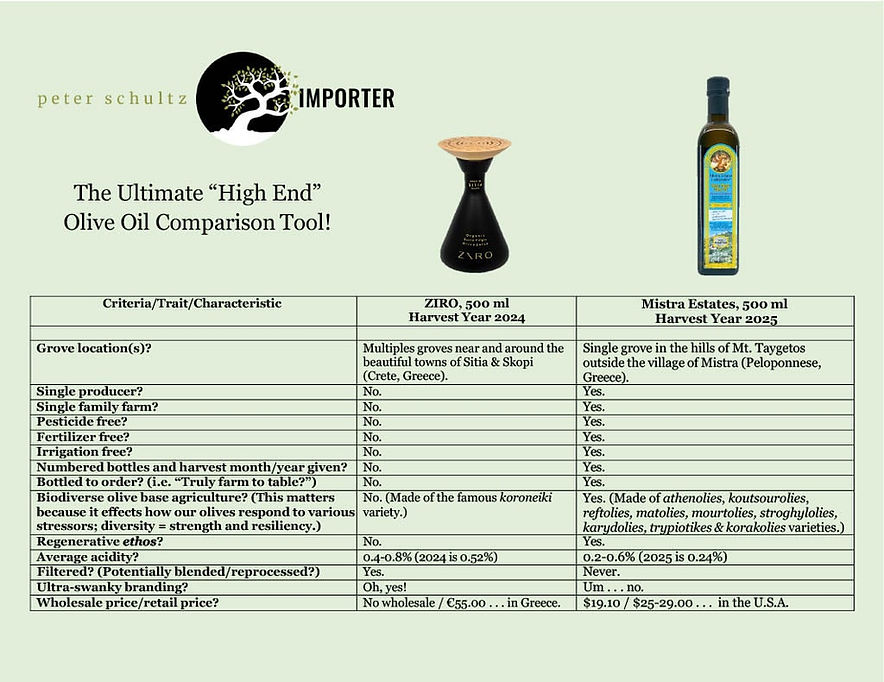FAQ
 |  |  |  |  |
|---|---|---|---|---|
 |  |  |  |  |
So, we’ve had several questions this year about what we do, how we do it, why we do it, and how this whole crazy olive oil thing started. So, for our new (and old) friends, we thought that we’d put together this little FAQ page so that everyone could get some decent answers to their great questions. These answers pertain to origins, ideals, shipping, delivery, pick-up, all of it. If you’d like to see this stuff on video, Tracy Briggs and Derek Fletcher made an award-winning documentary about this project last year that you can watch right here.
How did this whole extra-virgin olive oil adventure start?
The name of the Greek gentleman who farms our olives and presses our olive oil is Mr. Eugene Ladopoulos. Eugene is the husband of my PhD dissertation advisor at the University of Athens, Professor Olga Palagia. I met Eugene in 1997, during the first year he was bottling his olive oil. In fact, I was the graduate student-grunt-serf who helped hand-label the first bottles ever to come to America. He and I discussed the idea of bringing his extra-virgin olive oil (EVOO) here to the U.S., but it was just an idea back then . . . .
When did you import your first pallets of olive oil?
Our first pallet came in 2005, 20 years ago. I worked on that project with Tony and Sarah Nasello when they were running Sarello’s in Moorhead, MN. We brought over a half-pallet. And we couldn’t sell it. It was such good stuff and we just couldn’t move it. In the end, Tony and Sarah graciously bought my leftover inventory to use in the restaurant—they loved the stuff. If they hadn’t done that, we might never have been able to continue . . . .
I have friends who love to cook—how do they get in on this order?
Easy. If you know someone who you think would like what we do, then send them my email – peter@peterschultzimporter.com, or my number: +1.701.866.8660. We’ll add them to our mailing list. We have distribution points in Colorado (Aurora/Denver, Steamboat Springs), Illinois (Chicago), Kansas (Witchita), Massachusetts (Boston), Michigan (Grand Rapids), Minnesota (Alexandria, Brainerd, Detroit Lakes, Duluth, East Grand Forks, Fargo-Moorhead, Luverne, MSP, Rochester & Starbuck), North Dakota (Bismarck, Fargo Moorhead, Grand Forks), Missouri (St. Louis), South Dakota (Sioux Falls), Tennessee (Knoxville), Texas (Austin, College Station & Houston) and Wisconsin (Eau Claire, Madison, Milwaukee & Superior). And, of course, we offer FedEx shipping.
When I order a case from you, what am I getting, exactly?
Great question! When you order one case of bottles from us, you're getting 12 bottles with each bottle holding 0.5 liters (16.907 fluid oz.) of liquid gold. When you order one case of tins from us, you're getting 3 tins with each tin holding 3 liters (101.442 fluid oz.) of liquid gold.
Can I get this liquid gold by the bottle?
You bet you can. But not from me. We only sell wholesale, by the case. Best way to work around this is to go in on a case with some friends or family and split it. Lots of folks do that. Alternatively, you can always go to the Rourke Art Museum in Moorhead, 4e Winery in Mapleton, ND, Blackboard in Vergas, MN, Aspen Botanicals in Steamboat Springs, CO, or Good Strangers in Taylor, TX and pick up a bottle or two. These great places sell our oil retail and always have some available. Your local distribution point leader (in the cities noted above) will also have single bottles for sale.
Can I get it every month?
You bet you can. But not from me. It's important to remember that our oil is a seasonal product. If you want the freshest, best stuff, then you have to wait for when the olives are harvested, when they’re pressed, when the oil’s settled, and when it’s ready to package. That’s late summer/early fall, every year. The shelf life is a solid 5-6 years (or more) in a cool, dark place, so you can always stock up. (Our four-year-old stuff tastes 10x better than the “fresh” mass produced junk on the grocery store shelves anyway.) But we only order it when it’s at its best, once a year.
I’m sold. I’ll be ordering. How long will it take for my order to arrive?
Once our order closes on 31 August, our oil will be bottled, packaged, and shipped. Our shipment usually arrives before the middle of November. We always update all our customers every step of the way via email and Facebook. Once our shipment arrives, cases go out for delivery and for local pickup. Again, you’ll always get notifications with all necessary details and directions.
When I hold my oil up to light, it looks cloudy. And my older oil has sediment at the bottom of the bottle. What is this?
Our oil is bottled unfiltered. Cloudy oil is a sign of organic purity and quality. (You’ll never see cloudy oil on your grocery store shelf in the U.S.) Like all natural products, this haze is entirely normal, totally safe, and 100% good for you.
Do you offer local pickup?
Yes, indeed. As noted above, we have multiple pick-up spots, throughout the U.S.:
In Colorado, we have a pickup spot in: Denver/Aurora and Steamboat Springs.
In Illinois, we have a pickup spot in: Chicago.
In Kansas, we have a pickup spot in: Wichita.
In Michigan, we have a pickup spot in: Grand Rapids.
In Minnesota, we have pickup spots in: Alexandria, Brainerd, Detroit Lakes, Duluth, Luverne, Minneapolis/St. Paul, Moorhead, Rochester, and Starbuck.
In Nebraska, we have a pickup spot in Lincoln.
In North and South Dakota, we have pickup spots in: Bismarck, Grand Forks, and Sioux Falls.
In Missouri, we have a pickup spot in: St. Louis.
In Tennessee, we have a pickup spot in: Knoxville.
In Texas, we have pickup spots in: Austin, College Station, and Houston.
In Wisconsin, we have a pickup spot in: Milwaukee.
Do you offer international shipping?
We can ship to Canada, Mexico, and Puerto Rico, but it’s expensive. Other international shipping is prohibitively expensive, but please do reach out to me at peter@peterschultzimporter.com to talk details.
Is this really a “farm-to-table” kind of thing? Or is that just marketing nonsense?
We're the real deal. Our olives are hand-harvest in Mistra, pressed in Sparta, and bottled to order for us by the family that owns and farms the olive trees. The basic process is this: After our olives have been harvested, they’re pressed and the oil is allowed to settle. When our annual order period closes, Eugene and Giannis [Eugene’s nephew] bottle and package the oil, prepare the pallets, and drive the pallets to the Greek port of Piraeus for shipping. (Remember how the labels on our bottles always used to look kind of off-center? That's because up until two years ago, all the labels were put on the bottles by hand.) This is as real as it gets. No middle-men, no bundlers, no co-ops, no conglomerates. Just a farmer, his olives, and our customers. As for my role: I’m the importer, the wholesaler, and the on-line retailer, all at once. This setup allows us to pay Eugene more – and to charge our customers less. By keeping it real and avoiding unnecessary clutter, everyone wins. We can import the some of the oil, we can serve our communities, and we can share good things.
But what really makes this oil different?
Good question. Eugene has an old-school, regenerative outlook toward his orchard, his olive trees, and his olive oil. There are no human inputs. Wild boars disturb and root the soil and provide the fertilizer. There’s no artificial irrigation—you can’t find a hose on the farm. Wild oaks and local flowers live amongst the olive trees. Humans trim and harvest and (occasionally) plow, and that’s it. What this means is that there’re no “industrial controls” on Mr. Ladopoulos’s olive oil or how it tastes. Much like wine, every year our olive oil is entirely different. Of course, the acidity is always very low. When you compare these kind of processes to those that produce the oil typically found in American stores, it’s just apples and oranges. This is pure, regenerative, single-producer, cold-pressed, unfiltered, gravity-settled, extra-virgin gold from the heart of the Peloponnese. I’ve seen bottles of similar quality oil being sold for $60 dollars a bottle — in Greece. We sell it at wholesale for less than $2o a bottle — the U.S. Deep quality, deep value, and truth telling are our primary differentiators. To wit: In the fall of 2022, I got a bottle of amazing oil from Crete from a friend. We did a comparison. Now we run the comparison every other year. Here are the tabulated results:

What's up with your old-school labels? Why not have some swanky branding to go with your swanky oil? Don't you want the cool kids’ money?
Great question.
(Indeed, this question was even more interesting when we didn't have a label machine, back when Eugene was labeling all our bottles by hand and then hand stamping the bottle number/harvest date on every bottle.)
Anyway, here’s one answer: "We've decided to stick with Eugene's old-school style and his old-school design as a kind of ironic/intentional reaction to the last seventy years of branding frenzy and marketing addiction here in the U.S. Finding a designer to come up with a minimal mark is easy. There's nothing simpler; it takes no work, it takes no time, and AI can do it 5 seconds. (Indeed, when it comes to olive oil — or almost any other product — that's all there is out there: They come up with a sleek package, a smooth label — and then quadruple the price because it looks schmancy.) So, our brand is the subversion of contemporary branding? Pretty cool, right?" That right there, my friends? That's the hipster's answer. And it's about 95% nonsense.
The truth is simpler.
Eugene loves his bottles, his labels, his design, and his emperors. And so do we. More to the point, this is what Eugene and his family are offering us. How about this for radical: How about we just honor his vision and his product and call it good? About ten years ago, this "branding conversation" was an issue very near the center of our minds. I now understand that Eugene's old-school packaging is the ideal counterpart to his old-school oil, a reminder of an old-fashioned way of doing things, a way of doing things that's almost entirely gone. Of course, not everyone is going to get this. That's just fine. But those who do get it are going to get something else — some of the very best olive oil in the world.
So, what’s this that we’re always hearing about “EVOO fraud?” Is that really a thing?
Alas, yes. Deception in the world of extra-virgin olive oil is rampant; the industry is rife with conmen. If you’re interested, check out this book by my pal, Tom Mueller. It’s great and it gives the full story. If you’re more scientifically inclined, this 2011 report from the University of California, Davis tells a crazy tale. In summary, a panel of scientists concluded: “Of the five top-selling imported ‘extra virgin’ olive oil brands in the United States, 73 percent of the samples failed the IOC sensory standards for extra-virgin olive oils analyzed by two IOC-accredited sensory panels. The failure rate ranged from a high of 94 percent to a low of 56 percent depending on the brand and the panel.” It’s pretty bad. But, for this project, we’ve never had to worry about it. Why? Because we go over to the grove every year (sometimes twice a year), we visit the trees with Eugene, we inspect the facilities, we walk the land, and we hang out with the family. And our friends come with us, too. If you care about quality, truth, and the earth, then there's only one rule: Know who grows your food.
Lots of people like to buy local. Your olive oil isn’t exactly made in Fargo-Moorhead, is it? What do you think about this concern?
That’s a great one. It's super important. There are two answers, a practical answer and theoretical answer.
Answer #1 - Practical: It’s always a good idea to look for local everything — art, clothes, food, you name it. The “think globally/act locally” mantra is at the center of what we do. Buying local matters. Keeping transportation and packaging costs down is good for everyone. Supporting local businesses is good for everyone. That said, what should we do about products or staples that can’t (and won’t) ever be grown here in the Red River Valley? That’s a real question and we think it deserves real answers. There will always be food products that cannot be produced in the High Plains. In those instances, the concept of “thinking global/acting local” deserves more rigorous consideration. In our case, I think that what we’ve made here in Fargo/Moorhead is a bridge between two communities. Moorhead, MN and Mistra, Greece are now linked because of us. We built that bridge. We built it here. We built it in and for this community. Indeed, I'd argue that that bridge itself is a huge part of what we’ve constructed here. In that sense then, this is a local food project with a dedicated food mission grounded in the Red River Valley. I love this place. Fargo-Moorhead is my home. My grandparents lived in Moorhead for decades, my Mom was a Spud, my parents are MSUM Dragons, me and my brother and sisters are Cobbers, and I’ve lived here in Moorhead for over 20 years. Our food bridge is a product of those roots. It's a project was born and raised here. In every way that matters, this project is of this place.
Answer #2 - Theoretical: Perhaps just as importantly, I think it's worth asking ourselves if the geographical origin of a product is the most important thing that we should be considering when we shop. Aren’t the values, goals, ideals, and relationships that surround a product and producers just as important as 'where the thing was made?' I think they are. Consider the flipside: Are we doing right if we exclude regenerative coffee from our “local" farmer’s market because it was produced by a co-op of women in Panama who don't live in Fargo-Moorhead? Do we think that denying these farmer's access to our community (and to our markets) is “thinking globally?” For me, if “think global/act local” means that we can’t support responsible, organic, or regenerative producers all over the globe, then the slogan is just another scam. For us, it's simple: If a producer is engaged in authentic, responsible, organic and/or regenerative farming practice, then she’s taking care of our shared home, our shared planet. And that means that we should be taking care of her. One of the best thinkers on this topic is Robyn Wright. For Robyn, “Everywhere is local.” It's her slogan and it makes a lot of sense. For Robyn, “local” is about perspective and principles — not just place. She’s right. And it's obvious. Our “local” is always someone else’s “global.” And our “global” is always someone else’s “local.” That fact has governed our project and our practice for over twenty years. And it’s something of which we're extremely proud.
More questions?
Please contact peter@peterschultzimporter.com
or cady@peterschultzimporter.com for information.
(Or call Peter, anytime, +1.701.866.8660!)